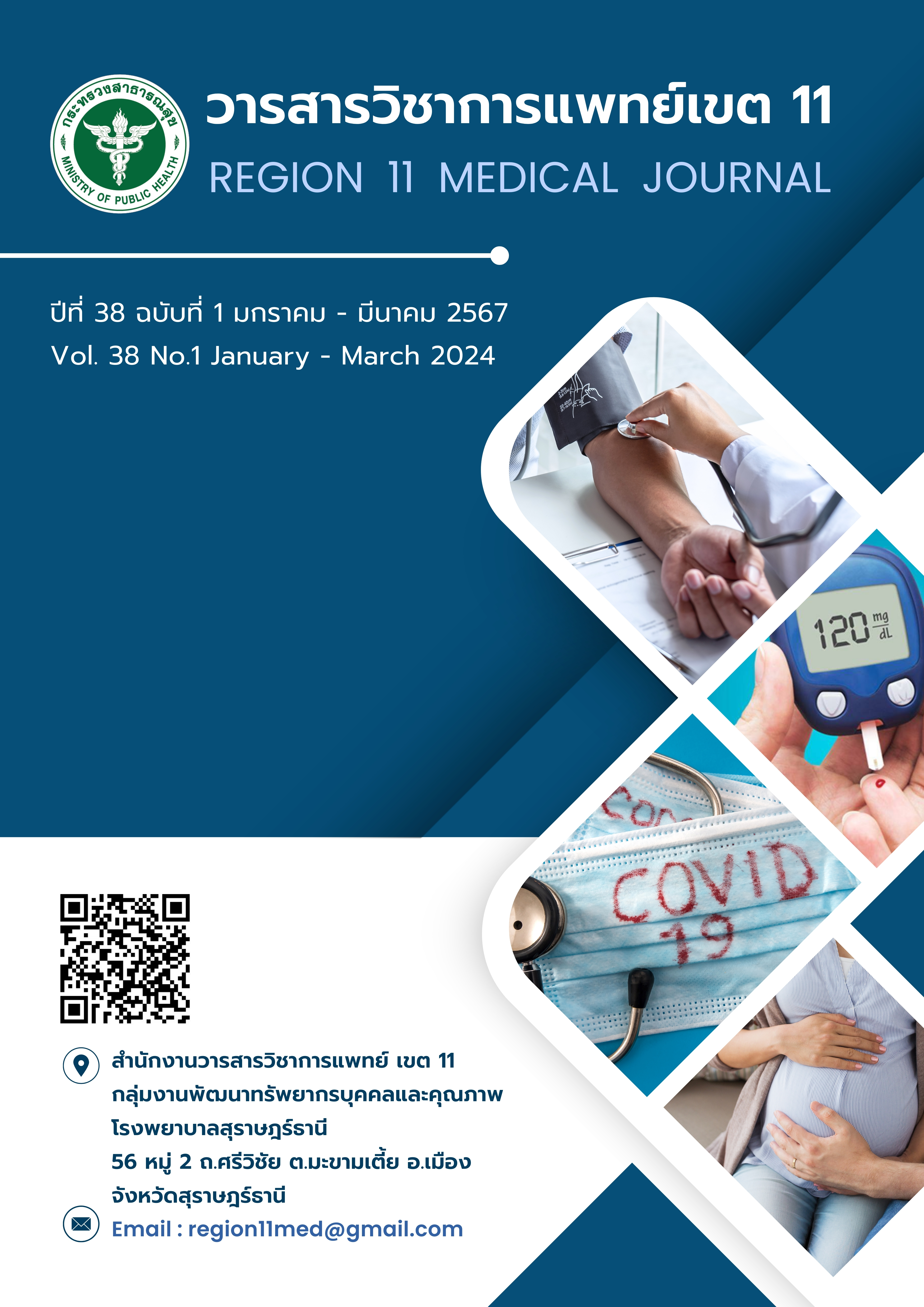Relationship between HPV Typing Non 16/18 and the results of the Liquid Base Cytology test of Thai women undergoing cervical cancer screening
Keywords:
CA Cervix, Cervical cancer screening, HPV typing Non 16/18, Liquid Base CytologyAbstract
Background: Infection with papillomavirus (HPV), encompassing types 16/18 as well as non 16/18 variants, presents a heightened susceptivity to the development of cervical cancer. It is imperative to underscore that the detection of non 16/18 HPV strains necessitates confirmation through Liquid Base Cytology screening methodology.
Objective: This retrospective study aimed to study the relationship between HPV Type Non 16/18 and the results of the Liquid Base Cytology test of Thai women undergoing cervical cancer screening.
Method: The purposive sampling technique was used for selecting a Thai woman undergoing cervical cancer screening at Sichon Hospital, Nakhon Si Thammarat Province, and has the HPV DNA Test results Typing Non 16/18 for the fiscal year 2022, numbering 144 cases. Data were analyzed using descriptive statistics, finding frequencies, and percentages, and finding relationships using chi-square statistics and Fisher extract tests.
Results: The results of the study found that Thai women who went for cervical cancer screening and had HPV DNA Test results as Type Non 16/18 with an average age of 46.11 ± 7.55 years, with an age range of 40-49 years (40.3%), HPV Multiple type 22 cases (15.3%), single type 122 cases (84.7%). The first 3 most common HPV types were 58 (23.6%), 52 (16%), and 51 (14.6%) with 31 (14.6%) having test results by the normal liquid base cytology method, including Negative for Intraepithelial Lesion or malignancy for 79 cases (54.9%) and positive test results for 65 cases, accounting for 45.1% of the number of positive test results. Abnormalities were found in 31 cases of LSIL (21.5%), ASC in 28 cases (19.4%), and HSIL in 6 cases (4.2%), and found that women with HPV typing Type Non 16/18 and having an age range of 50-59 years have the most NILM test results (46.8 %), while those aged 40-49 years have the most test results in the >ASC-US group (44.6%), which is a significant difference. Statistically significant (P-value = 0.048). The HPV Non 16/18 are not related to the Liquid Base Cytology test results (P-value = 0.048)
Conclusion: HPV DNA Test results as Type Non 16/18 are not related to the Liquid Base Cytology test results in Thai women who went for cervical cancer screening. However cervical cancer screening should be promoted to high-risk groups. Focusing on all high-risk HPV Types Non 16/18. Moreover, using such information to manage the health system in order to reduce the risks of the disease as well as increase the chance of treatment in the early stages. Consequently, the treatment will be effective. This is an important step in increasing quality of life and effectively reducing the burden of medical expenses on society.
References
Okunade KS. Human papillomavirus and cervical cancer. J Obstet Gynaecol. 2020; 40(5):602–8. doi: 10.1080/01443615.2019.1634030
Liang H, Pan Z, Cai X, Wang W, Guo C, He J, et al. The association between human papillomavirus presence and epidermal growth factor receptor mutations in Asian patients with non-small cell lung cancer. Transl Lung Cancer Res 2018;7:397-403.
ปิยวัฒน์ เลาวหุตานนท์, อาคม ชัยวีระวัฒนะ และ วีรวุฒิ อิ่มสำราญ. แนวทางการตรวจคัดกรอง วินิจฉัยและรักษาโรคมะเร็งปากมดลูก. กรุงเทพมหานคร: โฆสิตการพิมพ์; 2561.
ราชวิทยาลัยสูตินรีแพทย์แห่งประเทศไทย.แนวทางเวชปฏิบัติการตรวจคัดกรองมะเร็งปากมดลูก (Cervical Cancer Screening). กรุงเทพมหานคร:ราชวิทยาลัยสูตินรีแพทย์แห่งประเทศไทย; 2564.
International Agency for Research on Cancer (IARC). Globolcan 2012. [cited 2022 Mar 29]. Available from: http://globocan.iarc.fr/ Default.aspx.
เทียนแสง พันธ์ศรี, กฤติกา บุญมาก และจรัญญา งามขำ. การศึกษาย้อนหลังการติดเชื้อไวรัสฮิวแมนแพพพิวโลมาในประเทศไทย: การทบทวนอย่างเป็นระบบ.วารสารโรคมะเร็ง 2565; 42(1):10-29.
Sierra MS, Tsang SH, Hu S, Porras C, Herrero R, Kreimer AR, et al. Risk Factors for Non-Human Papillomavirus (HPV) Type 16/18 Cervical Infections and Associated Lesions Among HPV DNA-Negative Women Vaccinated Against HPV-16/18 in the Costa Rica Vaccine Trial. J Infect Dis. 2021; 224(3): 503-516. doi: 10.1093/infdis/jiaa768. PMID: 33326576; PMCID: PMC8496490.
Ma X, Yang M. The correlation between high-risk HPV infection and precancerous lesions and cervical cancer. Am J Transl Res. 2021; 13(9): 10830-10836. PMID: 34650762; PMCID: PMC8507010.
ศิริญญา เพชรพิชัย , ณัฐพร คล้ายคลึง อมรรัตน์ โพธิ์ตา อนุกูล บุญคง และ ปาริชาติ กัญญาบุญ. ความชุกของการติดเชื้อ Human papillomavirus สายพันธุ์เสี่ยงสูงของสตรีไทยในพื้นที่ จังหวัดพิจิตร อุทัยธานี ชัยนาท และก าแพงเพชร. วารสารกรมวิทยาศาสตร์การแพทย์. 2564;(4):766-786.
เนตรชนก ไวโสภา.ความชุกการเกิดมะเร็งปากมดลูกในโรงพยาบาลขอนแก่น ตั้งแต่ปี พ.ศ. 2558-2562. วารสารวิจัยและพัฒนานวัตกรรมทางสุขภาพ. 2564; 2(1): 113-22.
ธิดารัตน์ มละสาร. ความชุกและการกระจายตัวของการติดเชื้อไวรัสฮิวแมนแปปปิโลม่าของสตรีในพื้นที่อำเภอกมลาไสยจังหวัดกาฬสินธุ์. วารสารสุขภาพและสิ่งแวดล้อมศึกษา. 2565; 7(4): 114-22.
Downloads
Published
How to Cite
Issue
Section
License
Copyright (c) 2024 Region11Medical Journal

This work is licensed under a Creative Commons Attribution-NonCommercial-NoDerivatives 4.0 International License.






